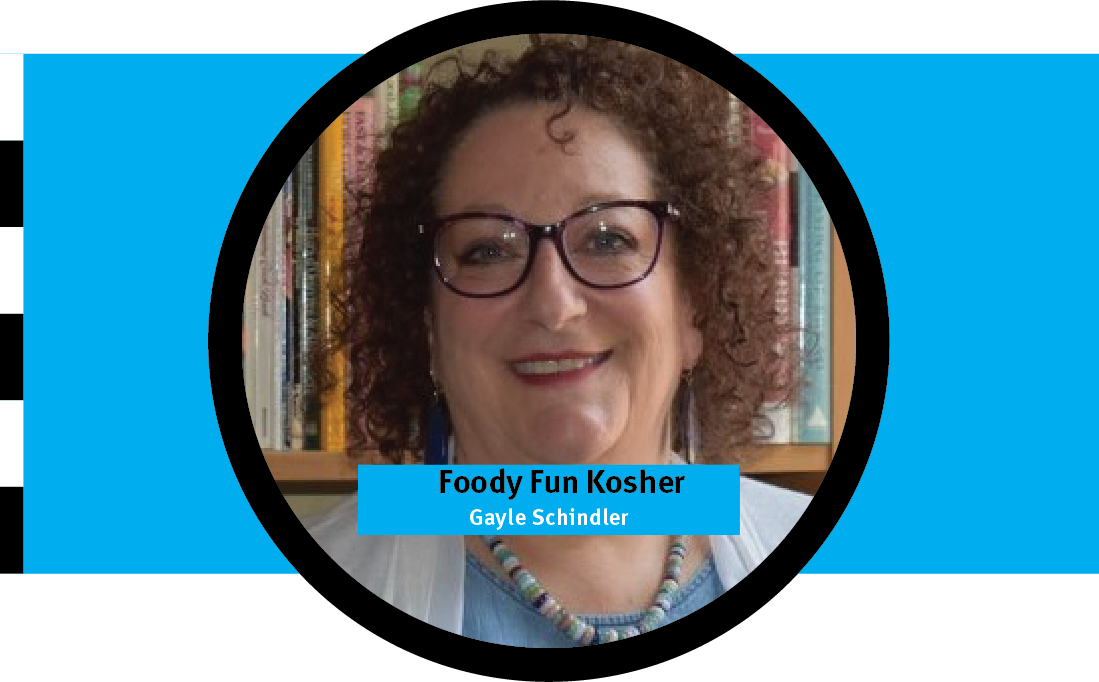This column marks my fifth anniversary as Food Writer for the American Israelite! I can hardly believe it. On the one hand, time passed so quickly. On the other, so much has happened.
I delivered my first column in March 2019. At that time, I expected to sell our home in New Jersey and move back to Cincinnati by summer of that year – early fall at the latest. But that didn’t happen. A terrible offer on our home fell through; we had to sink more money into the place and re-list with a better real estate agent.
The experience was painfully stressful, and we didn’t get back here until a whole year later – early March 2020. We all know what happened then. As we were finishing our packing and saying our final goodbyes, we were starting to hear rumors about a virus. People were getting sick. There was a lot of confusion.
I came first with my full car and our cat. My husband followed a couple of days later, driving a rented truck filled with stuff that didn’t fit anywhere else. We left his car with a friend in New Jersey, anticipating that Joel would go on a business trip the following week, return to Jersey, and drive it back to Cincinnati. That didn’t happen either. The world shut down and people started hoarding toilet paper.
Society is still reeling from the fallout of the pandemic, especially the food industry. While we were stuck at home, the country witnessed enormous changes to the ways people shopped and ate. We shopped at 7:00 in the morning to avoid crowds. We ordered groceries for pick-up or delivery, and we started ordering from online grocers too. We built outdoor pizza ovens, learned how to bake sourdough bread, and shared meals with friends sitting six feet apart in big outdoor circles.
We ordered takeout. Higher end restaurants, typically not set up for carry out, offered fancy meals to-go or almost-cooked meals for us to finish at home. Oh, and we discovered Zoom, which became a verb. We Zoomed wine tastings, cooking classes, seders, baby showers, and b’nai mitzvah.
TikTok exploded and we started watching some people prepare amazing meals and others mixing casseroles in their sinks (gross). Some of those talented, hardworking folks became celebrities, wrote cookbooks, and are touring the country now. Jake Cohen, whose first book, “Jew-ish” and second book, “I Could Nosh,” are best sellers, was just in Cincinnati last week. And two weeks ago, my sister and I drove to Columbus to see Idan Chabasov, aka The Challah Prince, demonstrate gorgeous multi-strand braids.
We stocked up on spirits and learned how to make craft cocktails. Then we realized we were drinking too much and we inspired a whole new class of non-alcohol beverages with adult flavors. We went from charcuterie/cheese boards to butter boards to everything else boards.
We are still coping with higher food prices at the supermarket and even higher prices when eating out. Restaurants have reduced their hours and staff, so we have to check whether they’re open on Mondays (or for lunch) and we need reservations to get into Sugar n’ Spice. The industry is trying to figure out how to deal with tipping. Servers and bartenders are either making more money than before or struggling to make ends meet, even with two or three gigs, depending on where they work, how they’re paid, and whether their owners and managers are fair or greedy.
On a more personal level, a lot happened to me and my family over the last five years too. As I said, we moved back to Cincinnati. Our oldest moved from Cleveland to Delaware to LA, started and finished graduate school, and started a consulting business. Our younger also came to Cincinnati, started and finished college, and is job hunting now. My husband just retired — sort of. I wrote one cookbook, am working on another, started teaching, and I’ve held several private board building events (I call them Booze n’ Boards). We’ve done some traveling and are planning to do more.
Here in the Israelite, this is my 72nd column. I’ve given you a whopping 120 recipes, most of them original. Over the last five March columns, I wrote about Passover twice and other topics three times. During the pandemic, I gave you a year’s worth of ideas to help cope. I suggested how to celebrate together while staying apart. I have covered so many Foody Fun subjects including seasonal cooking, flavors of the year, plant-based meat, kashrut, Jewish and secular holidays, dietary restrictions, tips, tricks, and menu ideas.
I run into you all over town. I love when you tell me that you enjoy my writing and my recipes. It has been an honor and a pleasure to write for you for these five years. Here’s to five more!!

Recipe: This month’s recipe, schnitzel, is a classic — in Europe, Israel, and around the world. Schnitzel was in my Mom’s regular rotation and it’s in mine too. It’s not hard to make, uses common ingredients that you should always keep in your STOCKED kitchen, and tastes great hot out of the pan or as cold leftovers. Once you master the technique, schnitzel is a canvas for unlimited variations.
History: The word, schnitzel, is a diminutive of the German word sniz, which means “slice.” Weiner Schnitzel is the Austrian version with which we are most familiar; it was traditionally made from veal. In Germany, it is often made with pork. Jägerschnitzel is one variation, served with a brown mushroom sauce, and Schnitzel Holstein is topped with a sunny side up egg. In both countries and in most of Eastern Europe, it is served with a lemon wedge.
But almost every country and culinary tradition has some form of schnitzel — meat sliced thin and pounded thinner, then breaded and fried. From France to Japan to Columbia, people everywhere figured out that this is a simple, delicious way to prepare slices of animal protein. Depending on where you are in the world, schnitzel is made from veal, pork, turkey, chicken, or even beef, which Americans call chicken-fried steak. And today it’s easy to find vegetarian proteins that can be prepared the same way – tofu, seitan, or brand-name plant-based cutlets.
Schnitzel is ubiquitous in Israel. While much of what we think of as Israeli cuisine is of Sephardic or Mizrahi origin, schnitzel came to Israel with Ashkenazi Jews, mostly after the Shoah. At that time, it was usually made with turkey breast, which was much more available in early Israel than even chicken, and it was fried in vegetable oil instead of the traditional Austrian butter for obvious kashrut reasons.
The Breading: I have always made schnitzel breaded with the classic 3-part method of flour, beaten egg, breadcrumbs. Flour helps the egg stick; egg helps the crumbs stick. You can season the egg and crumbs with anything you like. My mom used her holy trio of garlic powder, onion powder, and paprika plus salt and pepper. In Israel, sesame seeds are often added to the crumb. I use my favorite seasoning blend, but you can use any blend you like — steak rub, Italian seasoning, za’atar — any dried herbs or spices will work.
And here’s the genius — once you master the technique, you can switch out the crumb and seasoning to create unlimited flavor combinations. Instead of breadcrumbs, crush corn chips in your food processor. Add chili powder to the crumb and strained salsa to the egg; serve with guacamole and saffron rice. Or use crushed pretzels, put mustard in the egg, and serve with fries. Crushed wasabi peas + soy sauce and sesame oil delivers an Asian palette. Your imagination is the only limit.
Cut the Protein: My mom used to pound her cutlets, but I eliminated that step. Use a boneless breast. If it’s frozen, let it defrost about halfway. If it’s not, put it in the freezer for about half an hour. Use a sharp flexible knife to cut the breast across the equator — into thin slices. Depending on the thickness of your cutlet, you should get at least 3, maybe 4 slices. If your cutlet is very uneven — with one end much thicker than the other, cut it pole to pole where the thick end meets the thinner end and handle each piece separately. Remove the tender, pull out the tendon, and butterfly it.
Frying: Making a schnitzel is a frying technique; not a sauté. You need about ¼ to ½ inch of neutral vegetable oil in your pan to do it right. If your schnitzel is sticking, you don’t have enough oil. Fry until golden brown on both sides; if your slices are thin enough, it will take only 3 to 4 minutes per side. Work in batches, making sure to complete one batch before starting another. Drain the cutlets on paper towel layers; then place on a parchment lined baking sheet, tent with foil, and keep warm in the oven until serving.
Schnitzel Recipe
Ingredients:
Flour
Egg, beaten
Breadcrumbs
Chicken or turkey breast
Seasoning blend of your choice
Neutral oil
Directions:
- Slice the cutlet(s) across the equator into thin slices.
- Place the flour and breadcrumbs on 2 separate plates. Put the egg in a shallow bowl.
- Use the dry hand/wet hand method to bread the cutlets.
Use one hand to coat the cutlet on both sides with flour. Use the same hand to remove it from the flour and place it in the egg.
Use your other hand to coat both sides completely with egg. Lift the cutlet and let any excess egg drip back into the bowl. Place it in the breadcrumbs.
Use the first hand (your dry hand) to coat the cutlet in crumbs. Start by scooping some crumb onto one end of the cutlet to create a crumb-covered handle. Turn it over and press into the crumb. Make sure both sides are fully covered. - Remove to a clean plate. You can bread the cutlets early in the day and leave them in the fridge to set.
- When you’re ready to fry, heat about ¼ inch of oil in a medium hot skillet until you can see the oil start to move on top.
- Place cutlets into the oil carefully, laying them down away from you so hot oil doesn’t splash toward you.
- Use tongs to turn them after one side is golden brown — about 3 to 4 minutes.
- Remove to paper towels to drain; move to a parchment lined baking sheet to keep warm in the oven.





